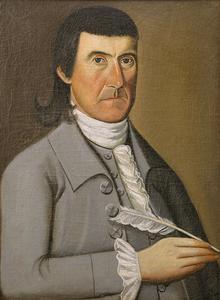
Cooke, Nicholas (1717-1782)
Role: Trustee, Rhode Island GovernorDates: 1766-1782, 1775-1778
Portrait Location: Library Annex
Artist: John Greenwood? (1727-1792)
Portrait Date:
Medium: Oil on canvas
Dimensions: 17 3/4
Framed Dimensions: 22 1/8
Brown Portrait Number: 152
Brown Historical Property Number: 446
Nicholas Cooke was a sea captain and merchant from Providence, Rhode Island. He sailed for and owned vessels with the town's wealthiest merchants. In 1766 when he was chosen to be a member of the board of the three-year-old Rhode Island College (later named Brown University), some trustees worried that he could not properly be considered a Baptist due to his past affiliations with the local Congregational Church. Cooke responded that he had, in fact, always been a Baptist on principle and had indeed been baptized by immersion in the Providence River (albeit a regularly occurring event on both sides of the River from a number of churches at this date). He added that if the Baptist Church had earlier adhered to the doctrine it espoused in 1766, he would have joined. The Board was persuaded and Cooke remained a trustee until his death. In 1770, he contributed ?45 toward the construction of the new college edifice. Cooke served as lieutenant governor of Rhode Island until Governor Wanton was deposed for his loyalty to the Crown in 1775. Cooke then took over the governorship for the first years of the Revolution.
Cooke's portrait has been attributed to John Greenwood, a Boston-born painter and engraver. Greenwood's father had been a prosperous merchant, but when he died, Greenwood sought to make a living as an engraver, apprenticing himself to Thomas Johnston. In 1745, he turned to painting full-time. At age twenty-five, he traveled to the Dutch Caribbean colony of Surinam, where he remained for five years. There he painted over a hundred portraits. His most famous work from this period, however, is the painting "Sea Captains Carousing in Surinam," in which a number of Rhode Island merchants are depicted drinking heartily around a large table. Captain Nicholas Cooke is present at the far end of the table smoking a long pipe. Unlike Greenwood's portrait of Cooke, most of his subjects are set against lavish backgrounds, attesting their affluence. Greenwood moved from Surinam to Holland, where he worked as an engraver, and finally settling in London in 1762, where he occupied himself as an art dealer for the remainder of his life.
In the 1960s this painting was glued to a masonite panel, irreversibly, by a well-intentioned paintings conservator, thus obscuring any evidence that might have confirmed the attribution to Greenwood.
